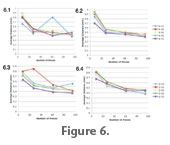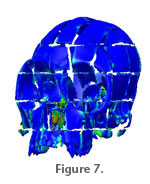| |
RESULTS
 The average distance calculations showed that there was very little difference between the fit of the deformed pieces on the original skull template versus the deformed skull template. The average distance calculations showed that there was very little difference between the fit of the deformed pieces on the original skull template versus the deformed skull template.
 There was less variation in the average distance scores between trials when fitting on the original skull template than on the deformed skull template (Figure 3). Overall the closest fit reconstructions, those with the smallest calculated average distances, were completed using the deformed skull template. Specifically the best-fit scores were produced by the X-15 and Z-75 trials, fitting on the deformed template (Figure 4,
Figure 5). There was less variation in the average distance scores between trials when fitting on the original skull template than on the deformed skull template (Figure 3). Overall the closest fit reconstructions, those with the smallest calculated average distances, were completed using the deformed skull template. Specifically the best-fit scores were produced by the X-15 and Z-75 trials, fitting on the deformed template (Figure 4,
Figure 5).
 The differences in the symmetry scores were similarly ubiquitous. There was no discernable difference in the results of the symmetry scores between the original skull template and the deformed skull template trials. There was more unpredictable variation within the trials fitting on the deformed skull template (Figure 6). The differences in the symmetry scores were similarly ubiquitous. There was no discernable difference in the results of the symmetry scores between the original skull template and the deformed skull template trials. There was more unpredictable variation within the trials fitting on the deformed skull template (Figure 6).
 The fit score demonstrated that the greater the number of pieces a specimen is split into, the better the fit. The best-fit reconstructions were accomplished using the deformed template on the 95 pieces trials. However, it is noteworthy that even the poorest score of fit that we found using only eight pieces was less than 1% of the maximum dimension of the skull (Figure
3, Figure 6). The fit score demonstrated that the greater the number of pieces a specimen is split into, the better the fit. The best-fit reconstructions were accomplished using the deformed template on the 95 pieces trials. However, it is noteworthy that even the poorest score of fit that we found using only eight pieces was less than 1% of the maximum dimension of the skull (Figure
3, Figure 6).
 The same is true for the symmetry score: even the worst score was less than 1% of the skull length (Figure
3, Figure 6). The same is true for the symmetry score: even the worst score was less than 1% of the skull length (Figure
3, Figure 6).
The color map plots revealed the areas that showed the worst fits. These areas were generally confined to the bone surrounding the major fenestra and holes in the skull including the orbit, the foramen magnum, the nasal cavity, and the zygomatic arch (Figure 7). These areas were also the areas of least symmetry.
|




